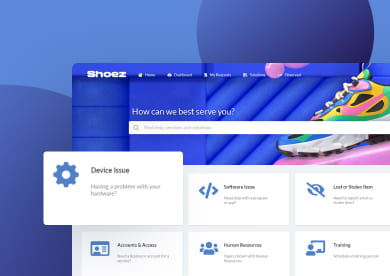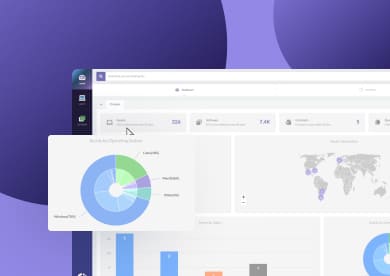DeepSeek has gained substantial traction, but its presence on corporate devices demands immediate attention from IT security teams.
It’s no news that employees from all industries are increasingly turning to AI assistants like DeepSeek to boost productivity, but organizations need to evaluate the security implications of these tools carefully.
If you need to remove DeepSeek from your network, we'll show you how to detect and uninstall it in bulk. This guide will help you set up automated alerts and a removal process with InvGate Asset Management to keep your organization secure and compliant.

Should organizations be concerned about DeepSeek?
There are several reasons why organizations might need to take a closer look at DeepSeek. We've gathered some important information to help you understand the potential risks.
To start, DeepSeek, like many AI platforms, collects substantial user data. According to their privacy policy, this includes:
- Your email address, phone number, and date of birth, entered when creating an account
- Any user input, including text and audio, as well as chat histories
- Technical information ranging from device models and operating systems to IP addresses and keystroke patterns
What makes this particularly concerning is that all this data is stored on servers in China. While the data collection itself isn't unusual - similar practices are used by ChatGPT and Gemini - the storage location introduces additional complexities due to different legal frameworks governing data access.
The security implications became even more apparent when DeepSeek suffered a major cyberattack in January 2025, and prominent cybersecurity firms like Wiz have identified several vulnerabilities in the platform, although DeepSeek has already addressed them.
As Emily Taylor, CEO of Oxford Information Labs, explained to BBC:
"For any openly available AI model, the prompts or questions asked of the AI become available to the makers of that model, as are the answers. Anyone working on confidential or national security areas needs to be aware of those risks."

Main reasons to remove DeepSeek from your organization
Drawing from our investigation, we can raise a clear warning: DeepSeek software, just like many other AI tools, deserves particular scrutiny in enterprise environments.
We already talked about some of the concerns in the previous section. For more clarity, let’s break down the main security and compliance concerns:
- Data storage location: All user data is stored on servers in China, potentially subject to data protection and access laws different from your organization's compliance requirements.
- Data collection: Beyond basic user information, DeepSeek collects and stores all conversations, technical device information, and even keystroke patterns - creating a digital footprint of your organization's activities.
- Documented security vulnerabilities: Cybersecurity firms have identified vulnerabilities in the platform, and DeepSeek itself experienced a significant security breach in January 2025.
- Broad data sharing practices: The platform's privacy policy allows them to share collected information with service providers, advertising partners, and its corporate group, with unclear retention periods.
- Limited control over data usage: Once information is submitted to DeepSeek, organizations lose control over how that data might be used or analyzed in the future.
- Compliance risk: As we mentioned, the combination of data storage location, collection practices, and sharing policies may conflict with various industry regulations and data protection requirements.
- Network security exposure: Having unauthorized AI software solutions or tools on corporate devices can create additional entry points for potential security breaches.
So, employees will probably use DeepSeek through their web browser. Wweb-based access to AI tools presents its own challenges. Organizations typically address this through:
- Web filtering policies
- Clear acceptable use guidelines
- Regular security awareness training
How to remove DeepSeek from your organization's computers
If you're ready to enforce a company-wide policy regarding the use of Deepseek, here's how to handle it effectively and ensure compliance across the board:
1- Start with clear communication
Before diving into technical solutions, we suggest you make sure you get everyone on board. Make sure everyone understands the new policy and why it's necessary. Informing employees about the reasons behind the decision helps create a culture of cybersecurity and compliance and reduces the need for strict enforcement. Inform:
- The security risks associated with unauthorized AI tools and software in general
- Which tools are approved for use
- The timeline for the removal process
2- Detect and remove DeepSeek
Some users might download and try to host the DeepSeek AI model internally. Tools like Ollama make this process straightforward, but even hosting the model internally has security implications. It won't connect to DeepSeek servers, but if you want to enforce a strict no-AI policy, we will share how to uninstall it in bulk.
Detecting installations across your organization is straightforward with InvGate Asset Management. Here’s how to handle it:
- Search for installations: Use the Search Bar with the query "Software Name.contains: Ollama" to get a complete view of all DeepSeek installations. You'll get a complete list of all devices with DeepSeek installed. Save this list as a custom view or export it for future reference.
- Create a removal plan: Develop a deployment script to push the uninstallation process to your organization's laptops. Once the script is ready, decide which machines need the uninstallation based on your detection results.
- Schedule removals: Plan the removals during appropriate maintenance windows or roll them out in batches for different departments to minimize disruption.
 3- Set up alerts
3- Set up alerts
Instead of just removing Ollama (or any other software you want to restrict) and hoping it stays gone, you can create a detection and response system. Here’s how to set up alerts with InvGate Asset Management.
When someone installs unauthorized software, the system can automatically:
- Notify the IT team about the new installation
- Send an educational message to the user about policy violations
- Schedule automatic removal if needed
- Confirm when the removal is complete
Moreover, this year, we will launch new software policy enforcement capabilities that will make this process even simpler, with granular control over what software can and cannot be installed.
In conclusion
Managing AI tools like DeepSeek in your organization requires a balanced approach, combining technical controls with clear policies and communication. While we're focusing on DeepSeek, similar concerns apply to many AI platforms, which should raise alarm bells for anyone worried about privacy.
Success depends on integrating these tools into a broader security strategy, so stay vigilant! Always check each tool's privacy policies, data handling practices, and compliance implications for your organization.
If you want to see how InvGate Asset Management can help you remove DeepSeek or other unauthorized software from your business devices, request our 30-day free trial now!















